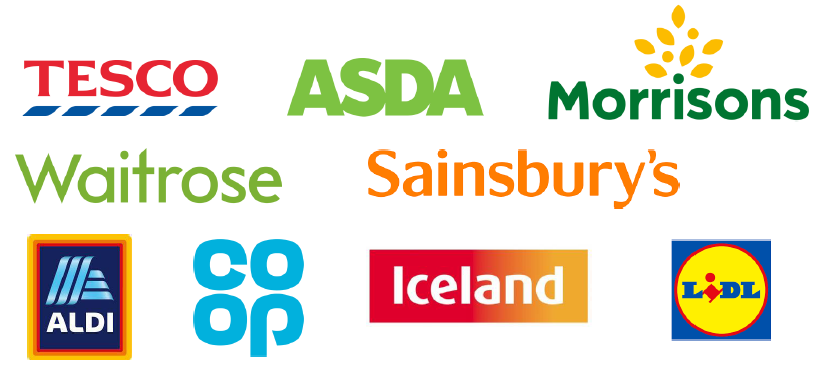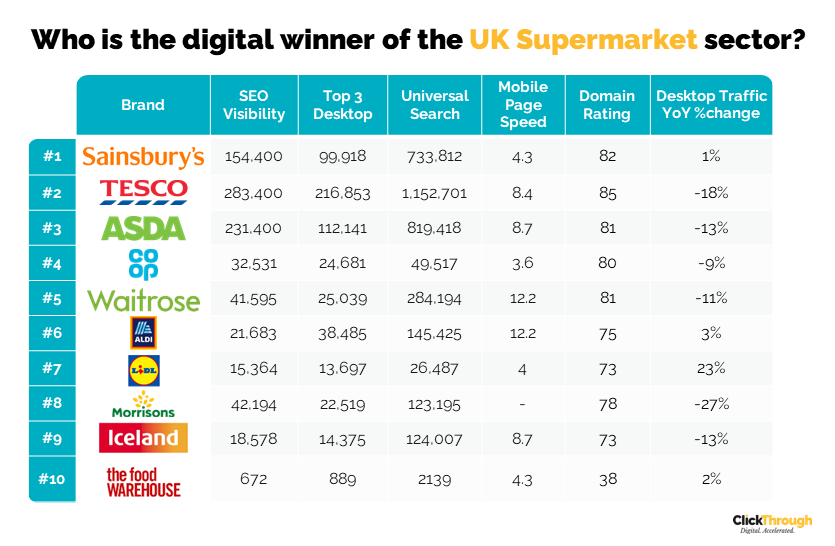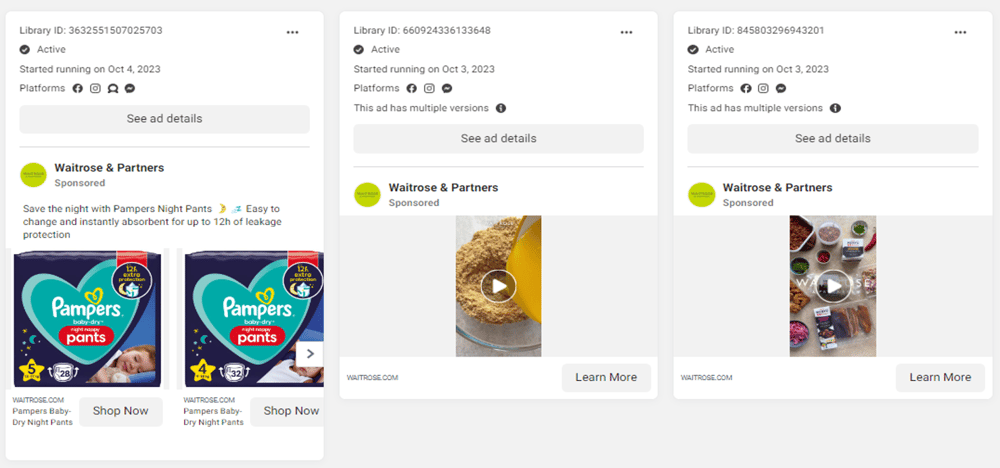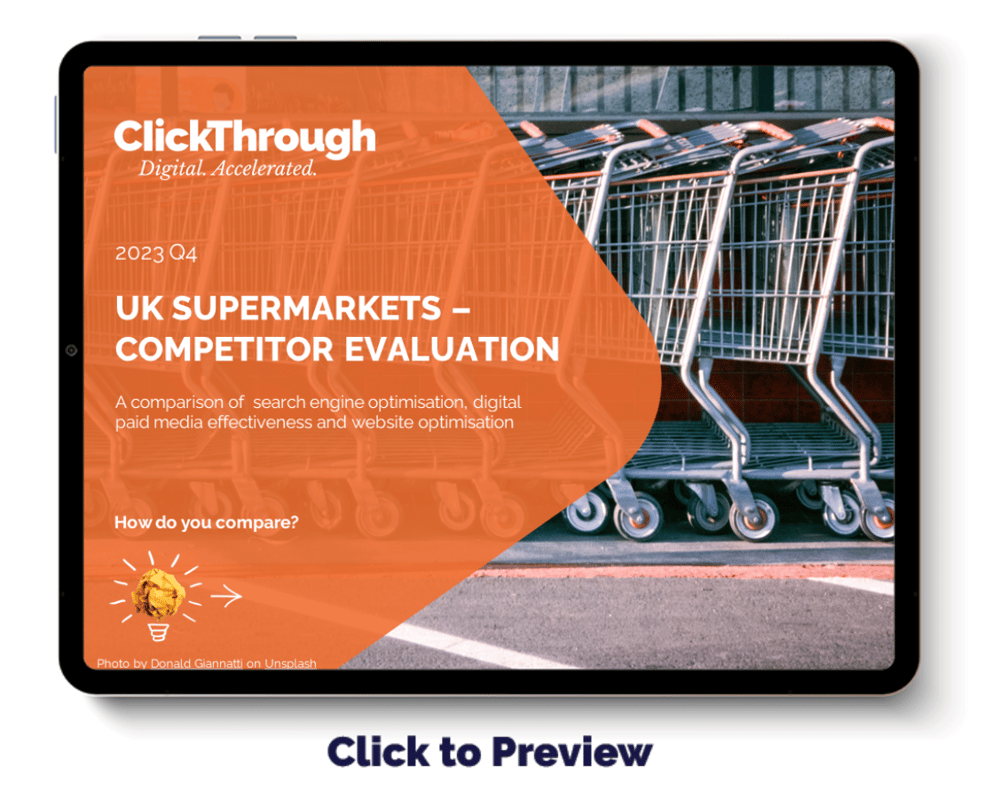The Q4 2023 benchmarking report for UK supermarkets has just been published. Learn how the top 10 UK supermarkets perform across the digital space.
The latest Q4 2023 benchmarking report for UK supermarkets has just been published. It covers the largest 10 national supermarkets, including Tesco, Asda, Waitrose, Aldi, Iceland, Co-op, Lidl, Morrisons, The Food Warehouse, and Sainsbury’s - it highlights year-on-year digital performance, plus winner and loser comparisons in 20+ online performance metrics.

The research gives an inside track on who is winning the biggest share of voice online, and quantifies the gaps, risks and missed opportunities for other supermarkets to win brand exposure, generate online orders, and drive in-store footfall. The report highlights quick wins that will improve enquiries from your online strategy and identifies the barriers that may be reducing your site’s ability to optimise digital performance.
To see a preview and contents page of the Q4 report, click here. To get a copy of the full report and the key takeaways, please complete the enquiry form or schedule a call.
Q4 2023 Winners and Losers Summary
For a glance into just 6 of the metrics we evaluated these top 10 supermarkets on, check out our quick-look table below;

Continue reading for further detail on this quarter's top and poorest-performing supermarkets, or request a copy of the report for the full review.
What The Industry Research Report Covers
The 70+ pages of research benchmarks each brand based on 50+ metrics and indicators of successful digital strategy, including organic visibility, domain authority, paid media ads, conversion performance, technical performance, site speed, universal search, content, social ads, accessibility, and mobile performance.
Driving Optimal ROAS from Paid Media Channels
Some of the leading players in the space are high spenders on paid media channels such as Google, Bing & Facebook - but have a poor or sub-optimal conversion improvement strategy. Without an optimised, sophisticated conversion strategy that maximises the conversion rate, the return on investment is unsustainable or will underperform. Scaling spend on paid media is not achievable unless the conversion rate delivers optimal performance in the sector. Some in the space have paid media spend levels from 30k+ per month but dedicate minimal resources and budgets to conversion testing. Given the cost per clicks on ad networks will continue to rise, we recommend spending at least 10% of your paid media budget on ongoing conversion optimisation testing schedules to ensure your paid media ROI maintains long-term viability, competitive advantage, and sustainability.
Technical Website Compliance
Savvy digital marketers know that having a technically sound website is an essential component of a successful fully integrated digital strategy - plus a site capable of maximising conversion performance. Supermarkets may find it challenging to stay on top of technical performance, due to the huge volume of product pages that they will need to maintain.
In Q2, we noted that Sainsbury's had returned 857 4xx error codes in our site crawls. This had been a significant increase compared to our previous reports, and indicated a slip in maintenance on the site. In Q4, Sainsbury's has reduced this to a much more respectable 34. Co-op is now showing the most 4xx errors, with 73 (though Asda is only one error behind).
Site Speed & Conversion Rate Performance
When 62% of consumers are less likely to convert if they have a negative mobile site experience, ensuring that your site is quick and easy to load makes a significant improvement on your overall conversion rates. Managing large sites can prove challenging when needing to maintain mobile page speed performance, but supermarkets can mitigate this by using smaller images where possible.
In our last report, we noted that only Co-op was achieving an 'okay' mobile page score, with a score of 74. While Co-op has seen this score drop to 55 in Q4, the brand remains the only supermarket site to surpass the 'okay' benchmark of 50. Waitrose has the slowest site, scoring only 8.
Building Competitive Advantage with Domain Authority
Domain authority is an essential metric for measuring the effectiveness of SEO performance and helps create a reliable overall gage of how effective your site is at achieving organic traffic, ie. ‘free’ traffic that isn’t gained through sponsored ads. Supermarkets have the opportunity to build their backlink profile and authority by capitalising on the huge range of products and brands that they stock. They can also run and take part in events within their local communities and for charities, helping them maintain their brand image, as well as securing links.
Domain authority is considered average between 40 and 50, good between 50 and 60, and excellent above 60. ‘Good’ DA score depends on the competition level of the industry. Domain authority for all supermarkets remains strong, with the top 9 scores ranging from 85 for Tesco, to 73 for Lidl. The Food Warehouse, a new brand for our report, is returning a DA of 38. While this is much lower than competitors, with a relatively new brand and site, it is to be expected. The Food Warehouse, part of Iceland, can look to mimic Iceland's approach to building DA and backlinks, in order to see quick improvements and reach a more competitive level.
Organic Performance – Mobile & Desktop
A strong organic performance is strategically important as it ensures your site ranks above competitors for key, transactional keywords. When 93% of your customers won’t go past the first page of Google, your absence or lack of targeting for essential keywords will cost you conversions.
Desktop remaind the most popular avenue for traffic for supermarkets, with four brands now seeing an increase in organic traffic, compared to 2022. Lidl has seen the biggest rise in digital footfall on desktop, securing 23% more visits YoY. Looking to mobile traffic, only The Food Warehouse has seen any increase in mobile visits, with an increase of 19%.
Universal Search Opportunity
Google Universal Search Results is an evolving opportunity to make your pages visible on a SERP (Search Engine Results Page). Universal results often appear before traditional listings and are eye-catching for users. Universal search results refer to rankings on a SERP that are not the traditional ‘blue line’ Google link, and a brand can appear for universal search results without being strong in standard rankings. 'Reviews', 'Local Pack', and 'People Also Ask' results are all useful results for supermarkets to target, helping them deliver additional information, directly on the SERP.
Tesco remains the strongest player for Universal Search results, with over 300,000 more appearances than any other supermarket. 'Reviews' make up the majority of Tesco's Universal Search results, with 553,200 results - this makes Tesco more likely to capture traffic from customers looking for reviews of specific products, even if they're not including 'Tesco' in their search phrase.
The Longtail Keyword Opportunity
Longtail keywords are often considered high intent and potentially more likely to convert as a searcher is being more specific. Optimising for longtail keywords also puts your content strategy in a strong position to rank for brand-new search terms as they enter Google’s index. Supermarkets showing for more long-tail keywords than their competitors can expect to scoop up traffic from lower-funnel search terms that are more likely to lead to a conversion or sale.
We've noted that Lidl has been steadily improving on longtail keywords, and is now ranking in the top three positions for 8,989 longtail search terms. Looking more broadly across the other supermarkets' performance, while Asda rank for the most longtail keywords overall, Tesco have secured the most appearances in the top three positions, showing a more thorough and well-considered approach to quality rankings over quantity.
Facebook Adverts
With the number of Facebook users in the United Kingdom (UK) forecast to hit over 42 million users by 2022, it is not surprising that companies have jumped at the opportunity to advertise on the social media platform. Facebook’s UK digital advertising revenue has been estimated to have breached 2.6b GB pounds in 2019. For supermarkets, they can use Facebook ads to drive in-store and online footfall in high-competition areas, along with ensuring visibility on key events and product lines.
We've included examples of Waitrose's recent Facebook ads below. Waitrose has used the carousel ad format to showcase baby-focused products, in a campaign that will be targeted towards parents of infants. In more widely targeted ads, Waitrose has used vertical video formats, showing food in an appealing setting. This will fit well in Meta's 'Reels' content, capturing the attention of a pre-enaged audience.

Top Social Shares & Content
When it comes to social media and on-site content strategies, it is important to release content that has a longer shelf life. An article is considered 'Evergreen' if it has maintained its relevancy to an audience for longer. It's great for your brand engagement, but great for Google too, who will recognise content which achieves traffic over a long period of time. Supermarkets can draw on content across their full range of products, using recipe content, home advice, and seasonal product lines to appeal to topical subjects and drive engagement.
Sainsbury's is now the only brand favouring Pinterest as a platform. This is a smart move, as the platform is a popular destination for recipe content and home inspiration, helping Sainsbury's gain visibility for both its food and homeware products. A glance at Sainsbury's profile shows a focus on food content, with most pins have strong, distinctive orange branding in addition to appealing lifestyle images (making them very 'pinnable' for other users).
Website Readability & Accessibility
20% of people in the UK have a disability – 2 million of which are people living with sight loss. In addition, 1 in 12 men and 1 in 200 women have some degree of colour vision deficiency. When websites are not designed to meet these needs, brands lose customer interest as they turn elsewhere. Grocery shopping is essential for everyone, so supermarkets should ensure their sites are accessible and do not exclude customers with additional accessibility needs.
Aldi and Waitrose have the most accessible sites of all ten supermarkets, with only one error and alert each. Sainsbury's has the biggest cause for concern, with 46 alerts. Looking in closer detail, these are mainly down to unclear heading formats which, though this isn't a great cause for concern, can cause some confusion for any visitors using screen readers to access the site.
GET THE FULL 79-PAGE Q4 2023 REPORT
To get a copy of the full report, please complete the enquiry form. If you want to talk to us about accelerating your digital performance, please call us on 01543 410014 or schedule a call with Mike Movassaghi.
Photo by Donald Giannatti on Unsplash






Let's be social
Join our growing social communities to learn more about the benefits of digital marketing and the people who make us tick.